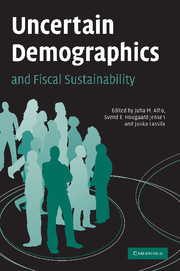Book contents
- Frontmatter
- Contents
- List of figures
- List of tables
- List of contributors
- Preface
- 1 Introduction
- Part I Uncertain demographics
- Part II Measuring sustainability in a stochastic environment
- Part III Enhancing sustainability
- Part IV Extensions
- 10 Macro-economic consequences of demographic uncertainty in world regions
- 11 Informational assumptions, aggregate mortality risk and life-cycle saving
- 12 Uncertain demographics, longevity adjustment of the retirement age and intergenerational risk-sharing
- 13 A general equilibrium analysis of annuity rates in the presence of aggregate mortality risk
- Comment: The economics of demographic uncertainty
- Index
- References
13 - A general equilibrium analysis of annuity rates in the presence of aggregate mortality risk
Published online by Cambridge University Press: 22 September 2009
- Frontmatter
- Contents
- List of figures
- List of tables
- List of contributors
- Preface
- 1 Introduction
- Part I Uncertain demographics
- Part II Measuring sustainability in a stochastic environment
- Part III Enhancing sustainability
- Part IV Extensions
- 10 Macro-economic consequences of demographic uncertainty in world regions
- 11 Informational assumptions, aggregate mortality risk and life-cycle saving
- 12 Uncertain demographics, longevity adjustment of the retirement age and intergenerational risk-sharing
- 13 A general equilibrium analysis of annuity rates in the presence of aggregate mortality risk
- Comment: The economics of demographic uncertainty
- Index
- References
Summary
Introduction
A life annuity provides an income stream for an individual's lifetime, thereby insuring them against the risk of unanticipated longevity. Annuities – whether provided by government implicitly through a public pension system, or purchased privately in an open market – consequently play an important role in financial planning for retirement throughout the developed world. Nevertheless, few studies have explored the workings of the annuities market, which is distinguished by its intertemporal nature and relation to demographic risk. This chapter therefore uses an overlapping-generations model to consider how the market-clearing annuity rate is affected by uncertainty regarding individual life span.
An annuity is defined by its annuity rate. This is the amount paid out to an annuitant, as a percentage of the purchase price of the annuity, while the annuitant is alive, with payment ceasing on the death of the annuitant. Because life spans are finite, fair annuity rates are typically higher than interest rates and for populations facing substantial immediate mortality risk (old people) they are considerably higher. Annuity rates offered on the UK market have fallen substantially over the last twenty-five years, from a high of 16 per cent for 65-year-old males in 1981, to 7 per cent in 2006. This long-term trend has been attributed to two principal factors. First, mortality rates have also fallen considerably over the same period – a 65-year-old male was estimated to have a life expectancy of 13.0 years in 1981, compared with 17.1 years in 2006.
- Type
- Chapter
- Information
- Uncertain Demographics and Fiscal Sustainability , pp. 258 - 269Publisher: Cambridge University PressPrint publication year: 2008
References
- 2
- Cited by



